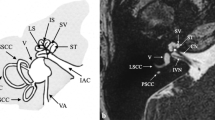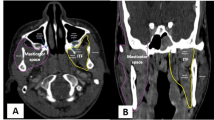Abstract
The orbits are easily identified on routine computed tomography (CT) and magnetic resonance imaging (MRI) imaging of the head and neck. Although there are many structures within the orbits, the overall structure of the globe is the most noticeable and can be an important source for pathology. In particular, many disease processes alter globe morphology and it is imperative that the radiologist be aware of not only the most common, but uncommon etiologies as well. This article provides an image-rich review of the wide range of emergent and non-emergent pathology that can result in altered globe contour.











Similar content being viewed by others
References
Gentry LR. Anatomy of the orbit. Neuroimaging Clin N Am. 1998;8:171–94.
Moore KL, Dalley AF, Agur AMR. Clinically oriented anatomy. Philadelphia: Lippincott Williams & Wilkins; 2013.
Chang L, Blain D, Bertuzzi S, Brooks BP. Uveal coloboma: clinical and basic science update. Curr Opin Ophthalmol. 2006;17:447–70.
Nakamura KM, Diehl NN, Mohney BG. Incidence, ocular findings, and systemic associations of ocular coloboma. A population based study. Arch Ophthalmol. 2011;129:69–74.
Pagon RA, Graham JM, Zonana J, Yong SL. Coloboma, congenital heart disease, and choanal atresia with multiple anomalies: CHARGE association. J Pediatr. 1981;99:223–7.
Kumar MK. Retrobulbar bilateral optic nerve colobomatous cysts; MRI & CT imaging features. J Cancer Prev Curr Res. 2016;4:144.
Smith M, Castillo M. Imaging and differential diagnosis of the large eye. Radiographics. 1994;14:721–8.
Hallinan JTPD, Pillay P, Koh LHL, Goh KY, Yu WY. Eye globe abnormalities on MR and CT in adults: an anatomical approach. Korean J Radiol. 2016;17:664–73.
Atchison DA, Jones CE, Schmid KL, Pritchard N, Pope JM, Strugnell WE, Riley RA. Eye shape in emmetropia and myopia. Invest Ophthalmol Vis Sci. 2004;45:3380–6.
Diogo MC, Jager MJ, Ferreira TA. CT and MR imaging in the diagnosis of scleritis. AJNR Am J Neuroradiol. 2016;37:2334–9.
Yangzes S, Sharma VK, Singh SR, Ram J. Scleromalacia perforans in reheumatoid arthritis. QJM. 2019;112:459–60.
Akpek EK, Thorne JE, Qazi FA, Do DV, Jabs DA. Evaluation of patients with scleritis for systemic disease. Ophthalmology. 2004;111:501–6.
Arej N, Fadlallah A, Chelala E. Choroidal tuberculoma as a presenting sign of tubercculosisi. Int Med Case Rep J. 2016;9:365–8.
Mohammadi F, Rashan A, Psaltis A, Janisewicz A, Li P, El-Sawy T, Nayak JV. Intraocular pressure changes in emergent surgical decompression of orbital compartment syndrome. JAMA Otolaryngol Head Neck Surg. 2015;141:562–5.
Nguyen VD, Singh AK, Altmeyer WB, Tantiwongkosi B. Demystifying orbital emergencies: a pictorial review. Radiographics. 2017;37:947–62.
Friedman DI. Papilledema and pseudotumor cerebri. Ophthalmol Clin North Am. 2001;14:129.
Lima V, Burt B, Leibovitch I, Prabhakaran V, Goldberg RA, Selva D. Orbital compartment syndrome: the ophthalmic surgical emergency. Surv Ophthalmol. 2009;54:441–9.
Suzuki H, Takanashi JI, Kobayashi K, Nagasawa K, Tashima K, Kohno Y. MR imaging of idiopathic intracranial hypertension. AJNR Am J Neuroradiol. 2001;22:196–9.
Sung EK, Nadgir RN, Fujita A, Siegel C, Ghafouri RH, Traband A, Sakai O. Injuries of the globe: what can the radiologist offer? Radiographics. 2014;34:764–76. Erratum in: Radiographics. 2014;34:8A.
Bord SP, Linden J. Trauma to the globe and orbit. Emerg Med Clin North Am. 2008;26:97–123.
Yuan WH, Hsu HC, Cheng HC, Guo WY, Teng MM, Chen SJ, Lin TC. CT of globe rupture: analysis and frequency of findings. AJR Am J Roentgenol. 2014;202:1100–7. Erratum in: AJR Am J Roentgenol. 2014;202:1396.
Roth A, Mühlendyck H, De Gottrau P. La fonction de la capsule de Tenon revisitée [The function of Tenon’s capsule revisited]. J Fr Ophtalmol. 2002;25:968–76.
LeBedis CA, Sakai O. Nontraumatic orbital conditions: diagnosis with CT and MRI imaging in the emergent setting. Radiographics. 2008;28:1741–53.
Ferreira TA, Grech Fonk L, Jaarsma-Coes MG, van Haren GGR, Marinkovic M, Beenakker JM. MRI of Uveal Melanoma. Cancers (Basel). 2019;11:377.
Lemke AJ, Hosten N, Wiegel T, Prinz RD, Richter M, Bechrakis NE, Foerster PI, Felix R. Intraocular metastases: differential diagnosis from uveal melanomas with high-resolution MRI using a surface coil. Eur Radiol. 2001;11:2593–601.
Midyett FA, Mukherji SK. Orbital imaging. Philadelphia: Elsevier; 2015. pp. 29–31.
Meltzer DE, Chang AHY, Shatzkes DR. Case 152: orbital metastatic disease from breast carcinoma. Radiology. 2009;253:893–6.
Author information
Authors and Affiliations
Contributions
All authors contributed to the review article conception and design. The first draft of the manuscript was written by Dr. Abhinav Patel and all authors commented on previous versions of the manuscript. All authors read and approved the final manuscript.
Corresponding author
Ethics declarations
Conflict of interest
A. P. Patel, A. A. Bhatt and A. T. Kessler declare that they have no competing interests.
Rights and permissions
About this article
Cite this article
Patel, A.P., Bhatt, A.A. & Kessler, A.T. Radiology of Abnormal Globe Contour. Clin Neuroradiol 31, 943–951 (2021). https://doi.org/10.1007/s00062-021-01049-7
Received:
Accepted:
Published:
Issue Date:
DOI: https://doi.org/10.1007/s00062-021-01049-7




